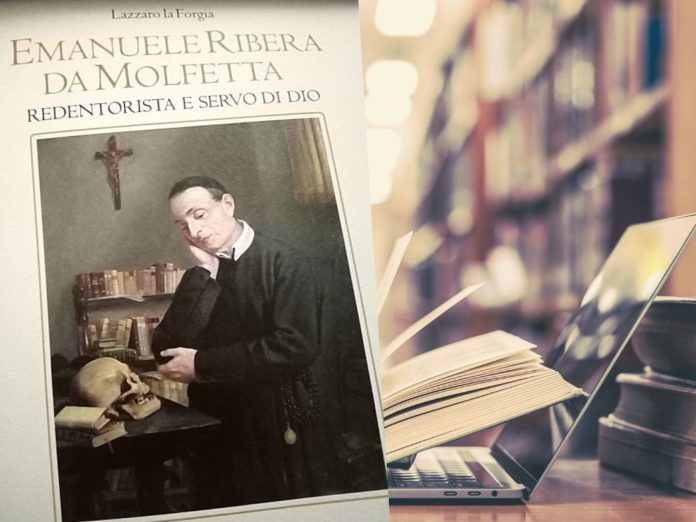Fr. Emanuele Ribera, C.Ss.R., 1811-1874, originally from Molfetta (Bari, Italy), was an appreciated spiritual director and a great apostle of the good press. Assisting the cholera victims in Pagani in 1836, he suffered a serious and prolonged illness that interrupted his missionary apostolate. The Superiors then assigned him to the care of the novices. He lived an intensely spiritual life, so much so that he was recognised as ‘a true saint’. He died in Naples at the age of 63.
Below we publish an abridged version of the book review by Fr. Vinenzo M. La Mendola, C.Ss.R. that he has written about the new Fr. Emanuele Ribera’ biography (L. La Forgia, Emanuele Ribera da Molfetta, Redentorista e Servo di Dio, Ed. La Nuova Mezzina, Molfetta (BA) 2020, pp. 44).
The Redemptorist Emanuele Ribera (1811-1874), defined coscentiarum moderator insignis (C. BENEDETTI, Servorum Dei e Congregatione Sanctissimi Redemptoris, Album quod in eorum causis actor…, Rome 1903, pp. 31-32), is a key figure in the history of the Neapolitan Church in the 19th century. For a long time, his memory risked being eclipsed. The last study of some of his spiritual writings dates back to 1970, by the well-known Redemptorist scholar Oreste Gregorio, who published Propositi, Lumi e avvisi spirituali. The book is part of the sixth volume of the Archivio italiano per la storia della pietà.
Fifty years later (1970-2020), his biographical profile is presented again in work by Lazzaro La Forgia, a citizen of Molfetta and a passionate researcher of local history, to bring it back to the attention of his fellow citizens and to reawaken their interest in one of the most representative historical figures of the nineteenth-century religion in Puglia, who has not always been given due recognition in local literature and memoirs, as is pointed out in the volume in question, noting the absence of his portrait and his name in Mauro Uva’s 1993 Galleria degli uomini illustri di Molfetta, a guide to the picture gallery in which the portraits of the city’s most important personalities have been collected (cf. p. 36). The author of the publication we are presenting wishes to remedy these, probably unintentional, glaring gaps, to restore Ribera to the history of his native city and the memory of its inhabitants. […]
From the pages of La Forgia’s book, another aspect of Ribera’s personality stands out, his love for study, appropriately recalled in the Presentazione, as one of the strong points of his actuality: “in a time like ours in which serious study is often sacrificed on the gridiron of notionism, or where the web churns out syntheses and copy-and-paste clippings for the use of those who thus delude themselves with the illusion of knowing, study truly remains a fine challenge that Father Emanuele launches to each one of us”. (p. 2).
Lazzaro La Forgia’s elegant brochure, faithful to the canons of synthesis and aesthetics and supported by a solid historical and bibliographical base, gathers abundant documentary material, tracked down through patient archival and bibliographical research. The wealth of images, photographs and reproductions is complementary to the narrative and is useful to the reader in getting to know places and people, most of which have never been seen before. Some scarce photographs and images of Ribera allow us to get to know his physiognomy and identify the path he took through devotional images that, over time, have borrowed his face and the distinctive elements of his personality and holiness (cf. pp. 8, 12, 26, 28, 41). In addition to this precious series, there are others of no less value, such as the reproduction of portraits of some bishops and ecclesiastics of Molfetta, numerous Redemptorists and other historical figures who populated the life of the servant of God. Of great interest is the sequence of photos depicting the places of his passage and memory: the church and house, now abandoned and ransacked, of the Redemptorists of St. Anthony in Tarsia, the place of his apostolate and burial, and the historic Redemptorist complex of Ciorani where relics and precious relics are preserved in the reconstructed room of the Servant of God and his mortal remains are kept in the monumental 18th-century church. Through this gallery, it is possible to visit “virtually” the places that preserve the traces of Father Ribera’s passage (cf. pp. 21, 25, 29, 31, 37), a possible stimulus to a visit-pilgrimage to the places of memory. This is one of the merits of the publication, responding to today’s reader’s needs, captured by images and attracted by brevity, often in search of unpublished places to visit.
So much remains to be discovered about “the Apostle of Naples”. Many of his writings, still buried – we hope in the ecclesiastical archives – and numerous letters are waiting to be retrieved and published in the hope of having further elements for a comprehensive knowledge of his human and spiritual life.
The intuition of Lazzaro La Forgia and the realization of his book may be the beginning of a new interest in the life and missionary activity of Fr. Ribera, followed, we hope, by other more substantial publications, intending to restore to history the physiognomy of a charismatic Redemptorist, the protagonist of a segment of the history of the Church still partly to be written.
P. Vincenzo M. La Mendola C.Ss.R.






